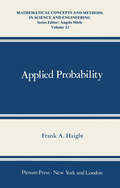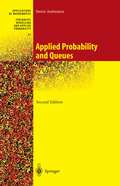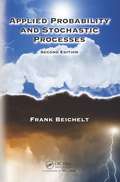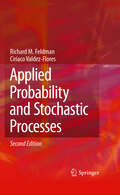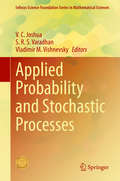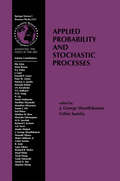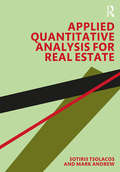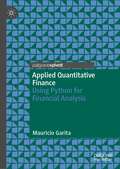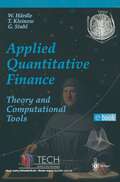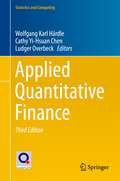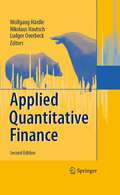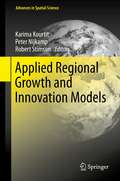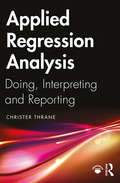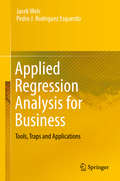- Table View
- List View
Applied Population Health: Delivering Value-Based Care with Actionable Registries (HIMSS Book Series)
by Barbara Berkovich, PhD, MA Amy Sitapati, MDElectronic Health Record (EHR) systems today provide increasing levels of clinical decision support and are the fulcrum for change for value-based healthcare delivery. Billions of dollars of government and insurer payments are dependent on evidence-based workflow design and quality report. In this context, quality measurement is no longer a retrospective exercise, but an essential prospective process embedded in clinical operations. Population health tools in the EHR enhance the efficiency and effectiveness of interventions thus improving the quality of care at lower cost. Population health methods are effective in ensuring that the right patient receives the right care at the right time. This book provides a clear framework for design, implementation, and monitoring of innovative population health tools to accelerate measurable improvements in care delivery. Key benefits for readers include conceptual framework, team approach, and technical insights that result in improved patient care, improved performance on quality measures and increased revenue from quality performance incentives and risk-based contracts. This is also a practice guide to the healthcare professionals many roles who are eager to build or improve population health programs with the goal of delivering high quality value-based care.
Applied Population Health: Delivering Value-Based Care with Actionable Registries (HIMSS Book Series)
by Barbara Berkovich, PhD, MA Amy Sitapati, MDElectronic Health Record (EHR) systems today provide increasing levels of clinical decision support and are the fulcrum for change for value-based healthcare delivery. Billions of dollars of government and insurer payments are dependent on evidence-based workflow design and quality report. In this context, quality measurement is no longer a retrospective exercise, but an essential prospective process embedded in clinical operations. Population health tools in the EHR enhance the efficiency and effectiveness of interventions thus improving the quality of care at lower cost. Population health methods are effective in ensuring that the right patient receives the right care at the right time. This book provides a clear framework for design, implementation, and monitoring of innovative population health tools to accelerate measurable improvements in care delivery. Key benefits for readers include conceptual framework, team approach, and technical insights that result in improved patient care, improved performance on quality measures and increased revenue from quality performance incentives and risk-based contracts. This is also a practice guide to the healthcare professionals many roles who are eager to build or improve population health programs with the goal of delivering high quality value-based care.
Applied Portfolio Management: How University of Kansas Students Generate Alpha to Beat the Street (Wiley Finance #368)
by Catherine Shenoy Kent McCarthyWhen investment professional Kent McCarthy returned to teach at his alma mater, the University of Kansas, he planted the seeds for the Applied Portfolio Management (APM) program—a course that allows students to manage a real money portfolio, which has compiled a remarkable record of investment success. Now, with this book, you’ll discover how to use the concepts covered in this class—from understanding the fundamental drivers of business success to buying at the right price—to enhance your own investment skills.
Applied Probability (Mathematical Concepts and Methods in Science and Engineering #23)
by Frank A. HaightProbability (including stochastic processes) is now being applied to virtually every academic discipline, especially to the sciences. An area of substantial application is that known as operations research or industrial engineering, which incorporates subjects such as queueing theory, optimization, and network flow. This book provides a compact introduction to that field for students with minimal preparation, knowing mainly calculus and having "mathe matical maturity." Beginning with the basics of probability, the develop ment is self-contained but not abstract, that is, without measure theory and its probabilistic counterpart. Although the text is reasonably short, a course based on this book will normally occupy two semesters or three quarters. There are many points in the discussions and problems which require the assistance of an instructor for completeness and clarity. The book is designed to give equal emphasis to those applications which motivate the subject and to appropriate mathematical techniques. Thus, the student who has successfully completed the course is ready to turn in either of two directions: towards direct study of research papers in operations research, or towards a course in abstract probability, for which this text provides the intuitive background. Frank A. Haight Pennsylvania State University vii Contents 1. Discrete Probability .................................................. 1 1.1. Applied Probability. . . . . . . . . . . . . . . . .. . . . . . . . . . . . . . . . . . . . . . . . . . . . . . . . . . . 1 1.2. Sample Spaces ......................................................... 3 1.3. Probability Distributions and Parameters. . . . . . . . . . . . . . . . . . . . . . . . . . . . . 7 1.4. The Connection between Distributions and Sample Points: Random Variables. . . . . . . . . . . . . . . . . . . . . . . . . . . . . . . . . 10 . . . . . . . . . . . . . . . . . . .
Applied Probability and Queues (Stochastic Modelling and Applied Probability #51)
by Soeren Asmussen"This book is a highly recommendable survey of mathematical tools and results in applied probability with special emphasis on queueing theory....The second edition at hand is a thoroughly updated and considerably expended version of the first edition.... This book and the way the various topics are balanced are a welcome addition to the literature. It is an indispensable source of information for both advanced graduate students and researchers." --MATHEMATICAL REVIEWS
Applied Probability and Stochastic Processes
by Frank BeicheltApplied Probability and Stochastic Processes, Second Edition presents a self-contained introduction to elementary probability theory and stochastic processes with a special emphasis on their applications in science, engineering, finance, computer science, and operations research. It covers the theoretical foundations for modeling time-dependent random phenomena in these areas and illustrates applications through the analysis of numerous practical examples. The author draws on his 50 years of experience in the field to give your students a better understanding of probability theory and stochastic processes and enable them to use stochastic modeling in their work. New to the Second Edition Completely rewritten part on probability theory—now more than double in size New sections on time series analysis, random walks, branching processes, and spectral analysis of stationary stochastic processes Comprehensive numerical discussions of examples, which replace the more theoretically challenging sections Additional examples, exercises, and figures Presenting the material in a student-friendly, application-oriented manner, this non-measure theoretic text only assumes a mathematical maturity that applied science students acquire during their undergraduate studies in mathematics. Many exercises allow students to assess their understanding of the topics. In addition, the book occasionally describes connections between probabilistic concepts and corresponding statistical approaches to facilitate comprehension. Some important proofs and challenging examples and exercises are also included for more theoretically interested readers.
Applied Probability and Stochastic Processes
by Frank BeicheltApplied Probability and Stochastic Processes, Second Edition presents a self-contained introduction to elementary probability theory and stochastic processes with a special emphasis on their applications in science, engineering, finance, computer science, and operations research. It covers the theoretical foundations for modeling time-dependent random phenomena in these areas and illustrates applications through the analysis of numerous practical examples. The author draws on his 50 years of experience in the field to give your students a better understanding of probability theory and stochastic processes and enable them to use stochastic modeling in their work. New to the Second Edition Completely rewritten part on probability theory—now more than double in size New sections on time series analysis, random walks, branching processes, and spectral analysis of stationary stochastic processes Comprehensive numerical discussions of examples, which replace the more theoretically challenging sections Additional examples, exercises, and figures Presenting the material in a student-friendly, application-oriented manner, this non-measure theoretic text only assumes a mathematical maturity that applied science students acquire during their undergraduate studies in mathematics. Many exercises allow students to assess their understanding of the topics. In addition, the book occasionally describes connections between probabilistic concepts and corresponding statistical approaches to facilitate comprehension. Some important proofs and challenging examples and exercises are also included for more theoretically interested readers.
Applied Probability and Stochastic Processes
by Richard M. Feldman Ciriaco Valdez-FloresThis book is a result of teaching stochastic processes to junior and senior undergr- uates and beginning graduate students over many years. In teaching such a course, we have realized a need to furnish students with material that gives a mathematical presentation while at the same time providing proper foundations to allow students to build an intuitive feel for probabilistic reasoning. We have tried to maintain a b- ance in presenting advanced but understandable material that sparks an interest and challenges students, without the discouragement that often comes as a consequence of not understanding the material. Our intent in this text is to develop stochastic p- cesses in an elementary but mathematically precise style and to provide suf?cient examples and homework exercises that will permit students to understand the range of application areas for stochastic processes. We also practice active learning in the classroom. In other words, we believe that the traditional practice of lecturing continuously for 50 to 75 minutes is not a very effective method for teaching. Students should somehow engage in the subject m- ter during the teaching session. One effective method for active learning is, after at most 20 minutes of lecture, to assign a small example problem for the students to work and one important tool that the instructor can utilize is the computer. So- times we are fortunate to lecture students in a classroom containing computers with a spreadsheet program, usually Microsoft’s Excel.
Applied Probability and Stochastic Processes (Infosys Science Foundation Series)
by V. C. Joshua S. R. S. Varadhan Vladimir M. VishnevskyThis book gathers selected papers presented at the International Conference on Advances in Applied Probability and Stochastic Processes, held at CMS College, Kerala, India, on 7–10 January 2019. It showcases high-quality research conducted in the field of applied probability and stochastic processes by focusing on techniques for the modelling and analysis of systems evolving with time. Further, it discusses the applications of stochastic modelling in queuing theory, reliability, inventory, financial mathematics, operations research, and more. This book is intended for a broad audience, ranging from researchers interested in applied probability, stochastic modelling with reference to queuing theory, inventory, and reliability, to those working in industries such as communication and computer networks, distributed information systems, next-generation communication systems, intelligent transportation networks, and financial markets.
Applied Probability and Stochastic Processes (International Series in Operations Research & Management Science #19)
by J. George Shanthikumar Ushio SumitaApplied Probability and Stochastic Processes is an edited work written in honor of Julien Keilson. This volume has attracted a host of scholars in applied probability, who have made major contributions to the field, and have written survey and state-of-the-art papers on a variety of applied probability topics, including, but not limited to: perturbation method, time reversible Markov chains, Poisson processes, Brownian techniques, Bayesian probability, optimal quality control, Markov decision processes, random matrices, queueing theory and a variety of applications of stochastic processes. The book has a mixture of theoretical, algorithmic, and application chapters providing examples of the cutting-edge work that Professor Keilson has done or influenced over the course of his highly-productive and energetic career in applied probability and stochastic processes. The book will be of interest to academic researchers, students, and industrial practitioners who seek to use the mathematics of applied probability in solving problems in modern society.
Applied Psychology for Project Managers: A Practitioner's Guide to Successful Project Management (Management for Professionals)
by Monika Wastian Lutz Rosenstiel Michael A. West Isabell BraumandlThis book offers an essential manual for project managers, project management offices (PMO’s), trainers and consultants, addressing the psychological side of project management. Written by leading scholars in organizational psychology and by top experts in project management, it covers all major psychological topics that are key to project success. The book features dedicated chapters on leadership and teamwork, including virtual and intercultural cooperation, commitment and motivation of project teams. It adds a psychological perspective to personnel management, decision-making, information and knowledge management and communication in project work. Power, influencing tactics and other aspects of stakeholder management are covered, as well as project coaching, innovation and creativity, self-management and the management of conflicts, risks and crises.
Applied Public Relations: Cases in Stakeholder Management (Routledge Communication Series)
by Kathy Brittain Richardson Marcie HintonWith its practical orientation and scope, Applied Public Relations is the ideal text for any public relations case studies or public relations management course that places an emphasis on stakeholder groups. Through the presentation of current cases covering a wide variety of industries, locations, and settings, Kathy Richardson and Marcie Hinton examine how real organizations develop and maintain their relationships, offering valuable insights into business and organizational management practices. The book’s organization of case studies allows instructors to use the text in several ways: instructors can focus on specific stakeholders by using the chapters presented; they can focus on particular issues, such as labor relations or crisis management by selecting cases from within several chapters; or they can select cases that contrast campaigns with ongoing programs or managerial behaviors. A focus on ethics and social responsibility underlies the book, and students are challenged to assess the effectiveness of the practices outlined and understand the ethical implications of those choices. This Third Edition features: 25 new and current domestic and international case studies specifically chosen for their relevancy and relatability to students New "Professional Insights" commentaries where practitioners respond to a set of questions relating to their work Increased emphasis on ethics and social responsibility Fully enhanced companion website that is connected with the text, including a test bank and PowerPoint presentations for instructors, and chapter-specific discussion questions and additional readings for students
Applied Public Relations: Cases in Stakeholder Management (Routledge Communication Series)
by Kathy Brittain Richardson Marcie HintonWith its practical orientation and scope, Applied Public Relations is the ideal text for any public relations case studies or public relations management course that places an emphasis on stakeholder groups. Through the presentation of current cases covering a wide variety of industries, locations, and settings, Kathy Richardson and Marcie Hinton examine how real organizations develop and maintain their relationships, offering valuable insights into business and organizational management practices. The book’s organization of case studies allows instructors to use the text in several ways: instructors can focus on specific stakeholders by using the chapters presented; they can focus on particular issues, such as labor relations or crisis management by selecting cases from within several chapters; or they can select cases that contrast campaigns with ongoing programs or managerial behaviors. A focus on ethics and social responsibility underlies the book, and students are challenged to assess the effectiveness of the practices outlined and understand the ethical implications of those choices. This Third Edition features: 25 new and current domestic and international case studies specifically chosen for their relevancy and relatability to students New "Professional Insights" commentaries where practitioners respond to a set of questions relating to their work Increased emphasis on ethics and social responsibility Fully enhanced companion website that is connected with the text, including a test bank and PowerPoint presentations for instructors, and chapter-specific discussion questions and additional readings for students
Applied Quantitative Analysis for Real Estate
by Sotiris Tsolacos Mark AndrewTo fully function in today’s global real estate industry, students and professionals increasingly need to understand how to implement essential and cutting-edge quantitative techniques. This book presents an easy-to-read guide to applying quantitative analysis in real estate aimed at non-cognate undergraduate and masters students, and meets the requirements of modern professional practice. Through case studies and examples illustrating applications using data sourced from dedicated real estate information providers and major firms in the industry, the book provides an introduction to the foundations underlying statistical data analysis, common data manipulations and understanding descriptive statistics, before gradually building up to more advanced quantitative analysis, modelling and forecasting of real estate markets. Our examples and case studies within the chapters have been specifically compiled for this book and explicitly designed to help the reader acquire a better understanding of the quantitative methods addressed in each chapter. Our objective is to equip readers with the skills needed to confidently carry out their own quantitative analysis and be able to interpret empirical results from academic work and practitioner studies in the field of real estate and in other asset classes. Both undergraduate and masters level students, as well as real estate analysts in the professions, will find this book to be essential reading.
Applied Quantitative Analysis for Real Estate
by Sotiris Tsolacos Mark AndrewTo fully function in today’s global real estate industry, students and professionals increasingly need to understand how to implement essential and cutting-edge quantitative techniques. This book presents an easy-to-read guide to applying quantitative analysis in real estate aimed at non-cognate undergraduate and masters students, and meets the requirements of modern professional practice. Through case studies and examples illustrating applications using data sourced from dedicated real estate information providers and major firms in the industry, the book provides an introduction to the foundations underlying statistical data analysis, common data manipulations and understanding descriptive statistics, before gradually building up to more advanced quantitative analysis, modelling and forecasting of real estate markets. Our examples and case studies within the chapters have been specifically compiled for this book and explicitly designed to help the reader acquire a better understanding of the quantitative methods addressed in each chapter. Our objective is to equip readers with the skills needed to confidently carry out their own quantitative analysis and be able to interpret empirical results from academic work and practitioner studies in the field of real estate and in other asset classes. Both undergraduate and masters level students, as well as real estate analysts in the professions, will find this book to be essential reading.
Applied Quantitative Finance: Using Python for Financial Analysis
by Mauricio GaritaThis book provides both conceptual knowledge of quantitative finance and a hands-on approach to using Python. It begins with a description of concepts prior to the application of Python with the purpose of understanding how to compute and interpret results. This book offers practical applications in the field of finance concerning Python, a language that is more and more relevant in the financial arena due to big data. This will lead to a better understanding of finance as it gives a descriptive process for students, academics and practitioners.
Applied Quantitative Finance: Theory and Computational Tools
by W. Härdle T. Kleinow G. StahlThis book presents solutions for many practical problems in quantitative finance. The e-book design of the text connects theory and computational tools in an innovative way. All "quantlets" for calculation of examples in the text are executable on an XploRe Quantlet Server (XQS) and can be modified by the reader via the internet. The electronic edition can be downloaded from the web.
Applied Quantitative Finance (Statistics and Computing)
by Wolfgang Karl Härdle Cathy Yi-Hsuan Chen Ludger OverbeckThis volume provides practical solutions and introduces recent theoretical developments in risk management, pricing of credit derivatives, quantification of volatility and copula modeling. This third edition is devoted to modern risk analysis based on quantitative methods and textual analytics to meet the current challenges in banking and finance. It includes 14 new contributions and presents a comprehensive, state-of-the-art treatment of cutting-edge methods and topics, such as collateralized debt obligations, the high-frequency analysis of market liquidity, and realized volatility.The book is divided into three parts: Part 1 revisits important market risk issues, while Part 2 introduces novel concepts in credit risk and its management along with updated quantitative methods. The third part discusses the dynamics of risk management and includes risk analysis of energy markets and for cryptocurrencies. Digital assets, such as blockchain-based currencies, have become popular but are theoretically challenging when based on conventional methods. Among others, it introduces a modern text-mining method called dynamic topic modeling in detail and applies it to the message board of Bitcoins. The unique synthesis of theory and practice supported by computational tools is reflected not only in the selection of topics, but also in the fine balance of scientific contributions on practical implementation and theoretical concepts. This link between theory and practice offers theoreticians insights into considerations of applicability and, vice versa, provides practitioners convenient access to new techniques in quantitative finance. Hence the book will appeal both to researchers, including master and PhD students, and practitioners, such as financial engineers. The results presented in the book are fully reproducible and all quantlets needed for calculations are provided on an accompanying website.The Quantlet platform quantlet.de, quantlet.com, quantlet.org is an integrated QuantNet environment consisting of different types of statistics-related documents and program codes. Its goal is to promote reproducibility and offer a platform for sharing validated knowledge native to the social web. QuantNet and the corresponding Data-Driven Documents-based visualization allows readers to reproduce the tables, pictures and calculations inside this Springer book.
Applied Quantitative Finance
by Wolfgang Karl Härdle Nikolaus Hautsch Ludger OverbeckRecent years have witnessed a growing importance of quantitative methods in both financial research and industry. This development requires the use of advanced techniques on a theoretical and applied level, especially when it comes to the quantification of risk and the valuation of modern financial products. Applied Quantitative Finance (2nd edition) provides a comprehensive and state-of-the-art treatment of cutting-edge topics and methods. It provides solutions to and presents theoretical developments in many practical problems such as risk management, pricing of credit derivatives, quantification of volatility and copula modelling. The synthesis of theory and practice supported by computational tools is reflected in the selection of topics as well as in a finely tuned balance of scientific contributions on practical implementation and theoretical concepts. This linkage between theory and practice offers theoreticians insights into considerations of applicability and, vice versa, provides practitioners comfortable access to new techniques in quantitative finance. Themes that are dominant in current research and which are presented in this book include among others the valuation of Collaterized Debt Obligations (CDOs), the high-frequency analysis of market liquidity, the pricing of Bermuda options and realized volatility. All Quantlets for the calculation of the given examples are downloadable from the Springer web pages.
Applied Quantitative Methods for Trading and Investment (The Wiley Finance Series)
by Christian Dunis Jason Laws Patrick NaïmThis book provides a manual on quantitative financial analysis. Focusing on advanced methods for modelling financial markets in the context of practical financial applications, it will cover data, software and techniques that will enable the reader to implement and interpret quantitative methodologies, specifically for trading and investment. Includes contributions from an international team of academics and quantitative asset managers from Morgan Stanley, Barclays Global Investors, ABN AMRO and Credit Suisse First Boston. Fills the gap for a book on applied quantitative investment & trading models Provides details of how to combine various models to manage and trade a portfolio
Applied Regional Growth and Innovation Models (Advances in Spatial Science)
by Karima Kourtit Peter Nijkamp Robert StimsonModern spatial-economic systems exhibit a high degree of dynamics as a result of technological progress, demographic evolution or global change. In the past decade, an avalanche of new regional economic growth and innovation models has been put forward. This volume contains a unique collection of operational models of a strong applied nature that may be seen as original landmarks in the rich tradition of spatial-economic growth modelling. The contributors are recognized experts from different parts of the world.
Applied Regression Analysis: Doing, Interpreting and Reporting
by Christer ThraneThis book is an introduction to regression analysis, focusing on the practicalities of doing regression analysis on real-life data. Contrary to other textbooks on regression, this book is based on the idea that you do not necessarily need to know much about statistics and mathematics to get a firm grip on regression and perform it to perfection. This non-technical point of departure is complemented by practical examples of real-life data analysis using statistics software such as Stata, R and SPSS. Parts 1 and 2 of the book cover the basics, such as simple linear regression, multiple linear regression, how to interpret the output from statistics programs, significance testing and the key regression assumptions. Part 3 deals with how to practically handle violations of the classical linear regression assumptions, regression modeling for categorical y-variables and instrumental variable (IV) regression. Part 4 puts the various purposes of, or motivations for, regression into the wider context of writing a scholarly report and points to some extensions to related statistical techniques. This book is written primarily for those who need to do regression analysis in practice, and not only to understand how this method works in theory. The book’s accessible approach is recommended for students from across the social sciences.
Applied Regression Analysis: Doing, Interpreting and Reporting
by Christer ThraneThis book is an introduction to regression analysis, focusing on the practicalities of doing regression analysis on real-life data. Contrary to other textbooks on regression, this book is based on the idea that you do not necessarily need to know much about statistics and mathematics to get a firm grip on regression and perform it to perfection. This non-technical point of departure is complemented by practical examples of real-life data analysis using statistics software such as Stata, R and SPSS. Parts 1 and 2 of the book cover the basics, such as simple linear regression, multiple linear regression, how to interpret the output from statistics programs, significance testing and the key regression assumptions. Part 3 deals with how to practically handle violations of the classical linear regression assumptions, regression modeling for categorical y-variables and instrumental variable (IV) regression. Part 4 puts the various purposes of, or motivations for, regression into the wider context of writing a scholarly report and points to some extensions to related statistical techniques. This book is written primarily for those who need to do regression analysis in practice, and not only to understand how this method works in theory. The book’s accessible approach is recommended for students from across the social sciences.
Applied Regression Analysis for Business: Tools, Traps and Applications
by Jacek Welc Pedro J. EsquerdoThis book offers hands-on statistical tools for business professionals by focusing on the practical application of a single-equation regression. The authors discuss commonly applied econometric procedures, which are useful in building regression models for economic forecasting and supporting business decisions. A significant part of the book is devoted to traps and pitfalls in implementing regression analysis in real-world scenarios. The book consists of nine chapters, the final two of which are fully devoted to case studies. Today's business environment is characterised by a huge amount of economic data. Making successful business decisions under such data-abundant conditions requires objective analytical tools, which can help to identify and quantify multiple relationships between dozens of economic variables. Single-equation regression analysis, which is discussed in this book, is one such tool. The book offers a valuable guide and is relevant in various areas of economic and business analysis, including marketing, financial and operational management.


